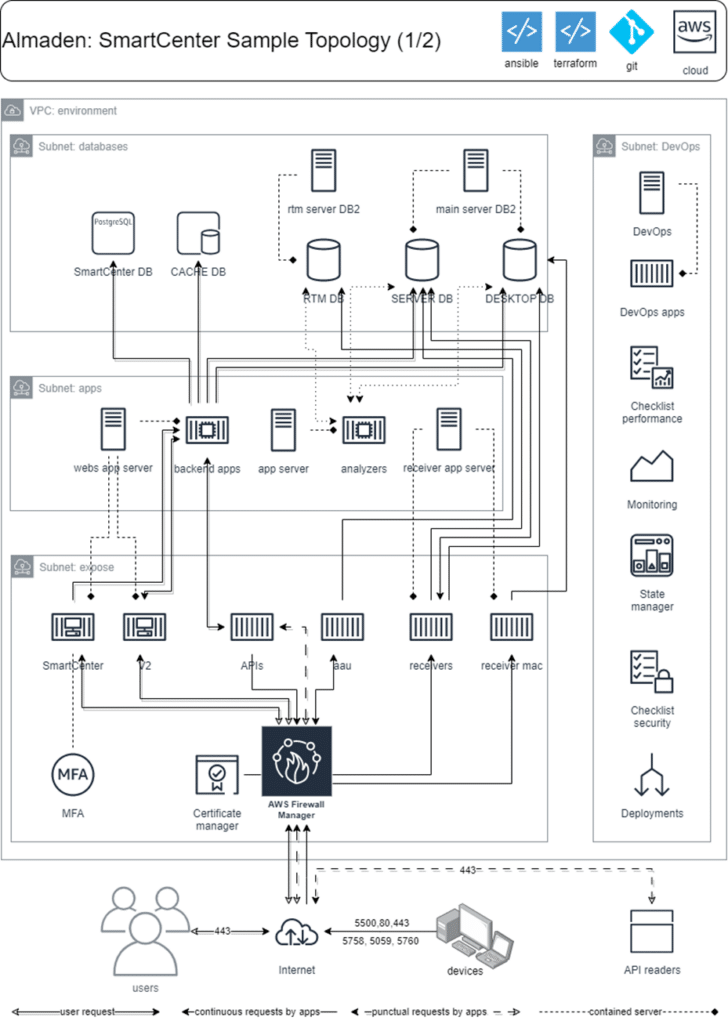Almaden – Topology
Introduction
This document aims to demonstrate and formalize the prerequisites of CIQ ITAM / SmartCenter. This includes the list of ports that must be opened, the agents that need to be previously authorized, and a description of their functions. Additionally, it provides an overview of the entire solution’s topology, whether it is internal in the Almaden cloud or in the client/partner environment where it will be implemented

CIQ ITAM / SmartCenter Applications (Cloud or Replica)
Receiver:
The Receiver is a component of the CIQ ITAM / SmartCenter solution responsible for receiving information sent by agents installed on servers and desktops. It centralizes the responsibility of receiving, decrypting, interpreting, and storing in a database all the information collected by the agents.
It ensures the security of the received data by authenticating the agents before allowing the transmission of information.
After receiving the data, the Receiver interprets and stores it in the corresponding database. It decrypts the received data and converts it to the appropriate format for storage. The Receiver is also responsible for filtering and enriching the data before storing it in specific databases of the CIQ ITAM / SmartCenter solution.
The Receiver is a critical component of CIQ ITAM / SmartCenter, as it is responsible for ensuring the integrity and reliability of the data collected by the agents. It is designed to be highly scalable, allowing it to handle large volumes of data and ensure that no data is lost or corrupted during the process of receiving and storing.
Site/Portal:
The CIQ ITAM / SmartCenter Portal is the data exposure layer of the solution. It is responsible for providing a user-friendly interface for viewing and managing data collected by agents and stored in the solution’s databases.
Through the Portal, users can view reports, charts, and dashboards with information about the performance, capacity, and configuration of servers and desktops managed by the CIQ ITAM / SmartCenter solution. In addition, the Portal allows users to manage their monitoring configurations and policies, such as adding or removing servers and desktops to be managed and configuring performance alerts.
The CIQ ITAM / SmartCenter Portal also provides advanced data analysis features, such as the ability to correlate performance events and perform root cause analysis to identify issues affecting the performance and availability of managed servers and desktops. The Portal is highly customizable, allowing users to create custom reports and dashboards based on their specific monitoring and management needs.
Databases
Server DB
Server DB is a database in DB2 used to centralize configuration information for the solution and server data. It stores CIQ ITAM / SmartCenter configuration information, such as server access credentials, server groups, and other general solution settings. In addition, it is also responsible for storing the information collected by CIQ ITAM / SmartCenter agents, which is sent to the Receiver and subsequently written to the database. This information includes server performance data, service status, running processes, hardware resource usage, and other useful information for server monitoring and management. The Server DB database is one of the key components of the CIQ ITAM / SmartCenter solution, as it is used to store and process most of the information collected by the solution’s agents.
Desktop DB
The Desktop DB database of the CIQ ITAM / SmartCenter solution is responsible for storing information about desktops. It contains data such as hardware configuration, installed software, security updates, disk usage, memory usage, event history, among other information.
The Desktop DB database in DB2 is used by CIQ ITAM / SmartCenter to provide desktop inventory information and for software and hardware asset management. It allows IT administrators to obtain accurate information about the desktops in their networks, which can help them identify issues and perform tasks such as software deployment, security patching, and hardware maintenance.
In Desktop DB, the Asset database is integrated with other parts of the CIQ ITAM / SmartCenter solution, allowing the data collected about desktops to be used in performance and capacity reporting and analysis. It is also used to support automation and policy management features, enabling administrators to define policies to automatically manage desktops based on the information collected by CIQ ITAM / SmartCenter.
RTM DB
RTM DB (Real-Time Monitoring Database) is a database in DB2 used by the CIQ ITAM / SmartCenter solution to store real-time monitoring data from servers and network devices. It is responsible for collecting raw performance data, including CPU usage, memory, network, storage, and other system resources.
The RTM DB is a high-speed, low-latency database designed to store and manage large volumes of data in real-time. It allows the CIQ ITAM / SmartCenter solution to monitor device performance in real-time and generate instant alerts and reports based on the collected metrics.
The data stored in the RTM DB is later transferred to other databases, such as the Server DB and Desktop DB, where it is converted and aggregated into more complex reports on performance, capacity, sizing, and other metrics.
Cache DB:
Cache DB is a cache database in REDIS used by CIQ ITAM / SmartCenter to speed up data delivery and store temporary data. It is an in-memory data structure that allows for quick storage and retrieval of data without needing to access the database again.
CIQ ITAM / SmartCenter DB:
The DB database in PostgreSQL used by CIQ ITAM / SmartCenter is responsible for storing customization information for the portal. It is used to store report configuration information, dashboards, users, and other custom settings defined by users.

